Excerpts from Jim Conrad's
Naturalist Newsletter
from the December 27, 2009 Newsletter issued from Hacienda Chichen Resort beside Chichén Itzá Ruins, central Yucatán, MÉXICO; limestone bedrock, elevation ~39m (~128ft), ~N20.676°, ~W88.569°
PICA-PICA/ VELVETBEAN
This time last year at Mayan Beach Garden Inn on the Costa Maya in Quintana Roo I was telling you about "Hamburger Beans," which beachcombing visitors collected washed up on the beach. That story is still at www.backyardnature.net/yucatan/mucuna.htm.
The very hard-shelled, hamburger-looking seeds that fascinated everyone were produced by Bean-Family species in the genus Mucuna, in pods very densely invested with slender, stiff, hairs. A Mucuna species is fruiting here now and you can see it, a vine with trifoliate leaves very like those of garden beans, below:
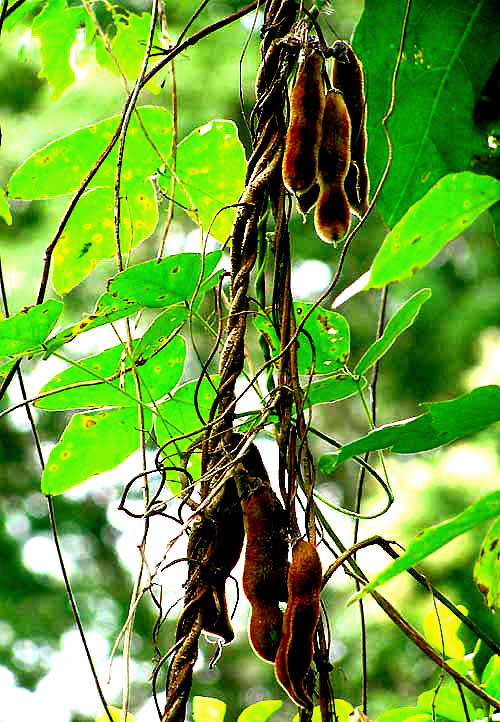
Below, you can see just how fuzzy those four-inch-long (10 cm) pods are.
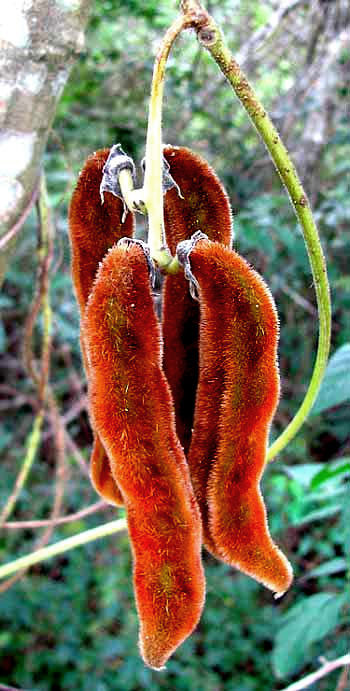
Back in the 70s when I worked in the herbarium of the Missouri Botanical Garden we always dreaded having to handle dried specimens of Mucuna because those pod hairs came loose, got on you, and made you itch until you took a scrubbing bath.
The species at hand here is MUCUNA PRURIENS, often called Velvetbean in English and Picapica in Spanish ("pica" means "to prick"), and though it's a native of India it now grows in tropical weedy areas worldwide. By the way, that species name "pruriens" is from the Latin meaning "itching sensation." I read that the hairs are a common ingredient of itching powder.
I'd expected Mucuna pruriens to be listed as having medicinal properties because I remembered from Standley's old Flora of British Honduras his statement that in Belize the legume's stinging hairs traditionally were mixed with molasses and taken as a medicine for expelling intestinal worms. However, I was surprised to see that the species is yet another of those "medicinal wonders" being sold at untold numbers of websites. Here are the most commonly mentioned uses:
As you might expect, most websites focus on its effects on sexual performance. (A typical dose for a man, I read, is 15 g of ground seeds mixed with cow's milk.)
However, the wider world of science seems most interested in the fact that the seeds contain natural L-dopa, used for controlling Parkinson's Disease. You can read much more about Mucuna pruriens' medicinal uses, including its preparation and side effects, at http://www.rain-tree.com/velvetbean.htm.
from the August 29, 2010 Newsletter issued from Hacienda Chichen Resort beside Chichén Itzá Ruins, central Yucatán, MÉXICO; limestone bedrock, elevation ~39m (~128ft), ~N20.676°, ~W88.569°
LUSTY PICA-PICA
It's way too early for Pica-Pica to be flowering or fruiting, but it's definitely making its presence felt, at least to Luis the milpa planter, as shown below:
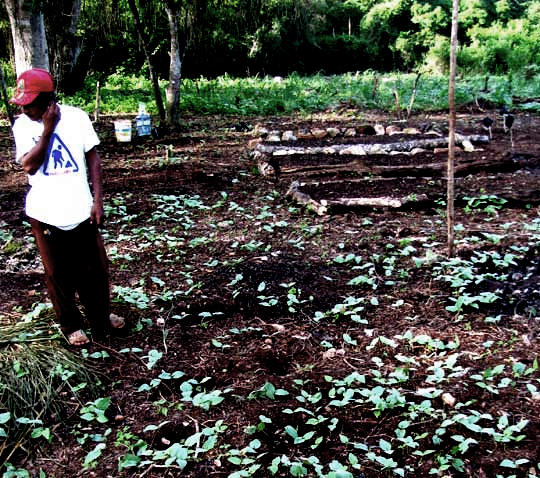
That picture shows a very discouraged and disgusted Luis. On Saturday he'd cleaned every weed from the area he's standing in, but now on Monday morning the ground is littered with hundreds of vigorous, new green shoots, and that's Pica-Pica. Before this area was cleared for the milpa, actually Pica-Pica hadn't been among the most conspicuous species. However, you can see that now, if left untended, in a day or two there'll be a rampant, garden-choking carpet of Pica- Pica.
Pica-Pica, MUCUNA PRURIENS, is such a tough, vigorous plant that you just have to admire it -- unless you're Luis.
By the way, in the background and to the right notice the low earthen beds framed with rocks and stems of fallen trees. The Maya call those "eras," and they're special for this culture. The Yucatán's soil is so thin and often impoverished that sometimes good soil must be collected here and there and collected in "eras" so that plants will have something to root in. In some places in the Yucatán I've seen people sneak onto private property at night and rob topsoil, carrying it home in bags. The Maya here also put such earthen beds on wooden platforms with legs, and those structures are called "canchés."
Beyond the eras you can make out Luis's knee-high corn, among which also are planted squash and beans.
from the November 7, 2010 Newsletter issued from Hacienda Chichen Resort beside Chichén Itzá Ruins, central Yucatán, MÉXICO; limestone bedrock, elevation ~39m (~128ft), ~N20.676°, ~W88.569°
PICA-PICA'S PURPLE FLOWERS
Now those Pica-picas, MUCUNA PRURIENS of the Bean Family, are issuing handsome, dangling, ten-inch long (25cm) racemes of violet-purple flowers, reminiscent of climbing Wisteria and Kudzu vines, as shown below:
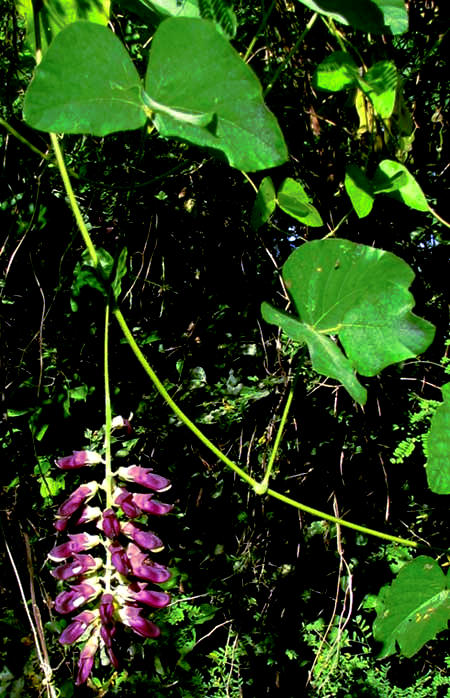
Since Pica-picas belong to the Bean Family, their flowers share the basic structure of other Bean Family members: A large petal called the standard or banner stands above the rest of the flower, two petals called wings are arranged along the sides, then the two bottom petals are joined along a common side to form a boatlike scoop called the keel. You can see all this below:
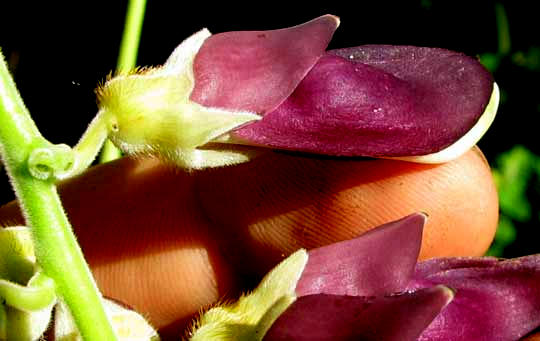
In that photo the largest, dark petal is a wing, the standard or banner above it is slightly paler, and the whitish keel barely extends beyond the wing.
After the flowers have been open awhile the petals wilt and fall off, leaving the sexual parts stiffly poking into the air. You can see what that looks like below:
>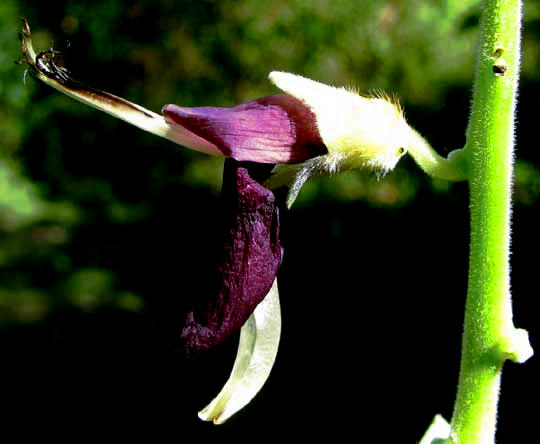
The upward-arcing item at the picture's extreme top. left is the stigma, which receives pollen during pollination. The stigma stands atop a necklike style, which leads to the ovary hidden inside the flower. The numerous black, curled items just below the stigma are drying-up anthers and filament ends, the filaments joining below to form a cylinder surrounding the ovary and style. All these details are just like you find in the flowers of thousands of other Bean Family species.
One unusual feature of the Pica-pica flower, however, is the calyx's covering of sharp, slender, reddish hairs. The calyx is the cuplike thing from which the rest of the blossom emerges. You can see what happens if you just touch the tip of your finger to that calyx below:
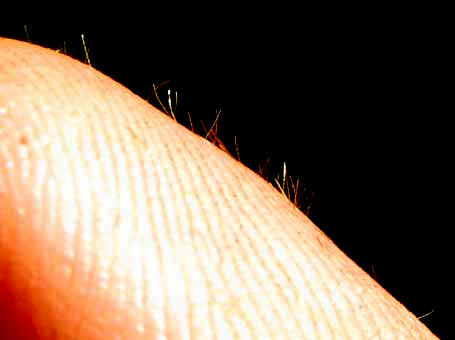
If you get those little hairs down your shirt when you're hot and sweaty, you have a miserable day before you.
Issued on February 7, 2020 from the forest just west of Tepakán; elev. ~9m (~30 ft), N21.053°, W89.052°; north-central Yucatán state, MÉXICO
MATURE LEGUMES
The picture below shows more mature legumes than seen above:
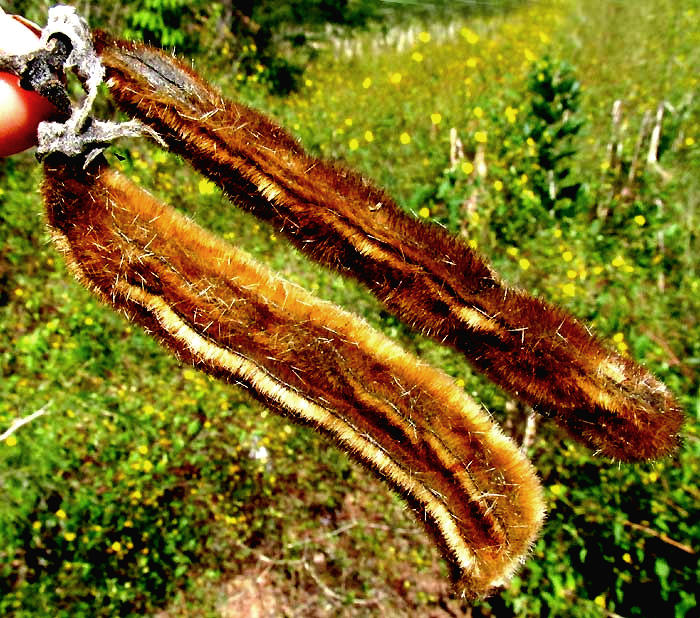
On these pods it's easier to see the "longitudinal costa remote from the margins on each valve," as Paul Standley and Julian Steyermark describe them in their 1946 Flora of Guatemala treatment of the family Leguminosae. They're referring to the vein-like ridges running down the face of each side of the legumes.